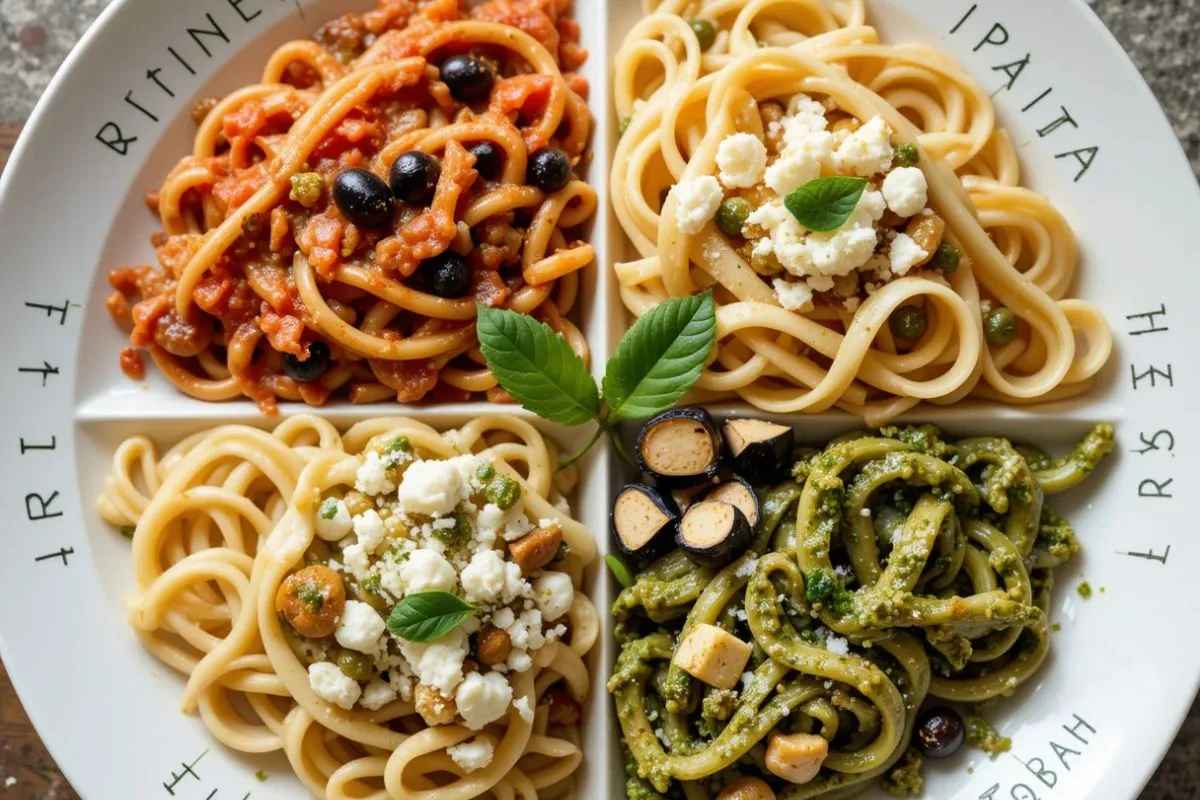Pastasciutta Recipe – The Ultimate Guide to This Classic Italian Dish
Table of Contents
Introduction to Pastasciutta
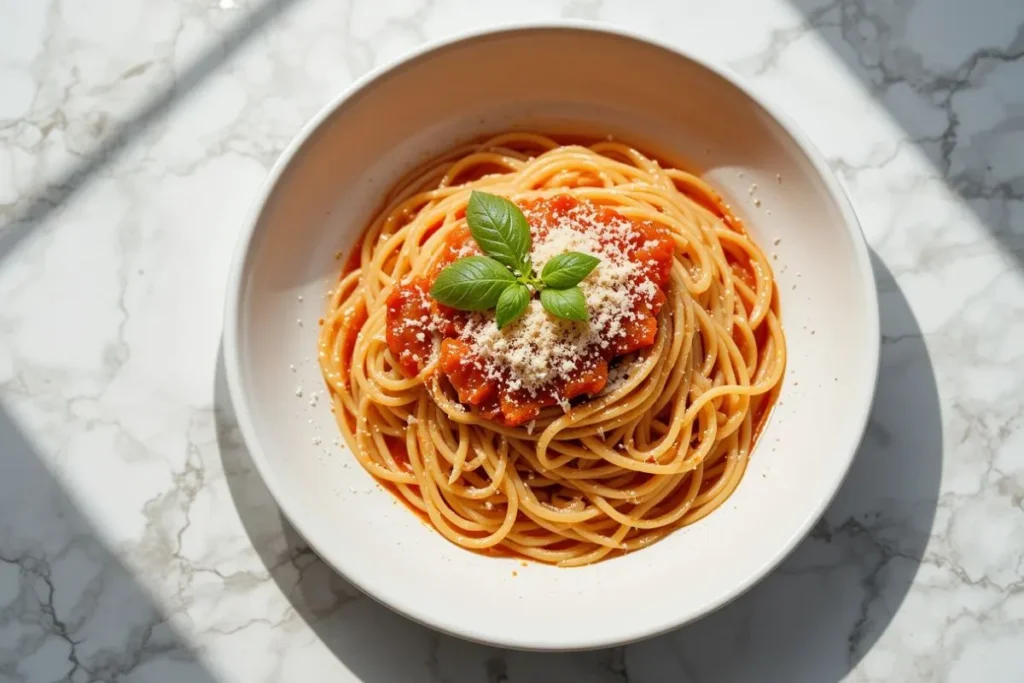
What Is Pastasciutta?
Pastasciutta, often affectionately referred to as “dry pasta,” is one of Italy’s most beloved and versatile dishes. Contrary to what the name might suggest, it’s not literally dry. The term “pastasciutta” distinguishes it from pasta served in broth (like minestrone or tortellini in brodo). This dish features cooked pasta served with a sauce—typically tomato-based, though not exclusively—and often enriched with meat, vegetables, cheese, or herbs.
Unlike the heavy, cream-laden pasta dishes found in some Western interpretations, pastasciutta is all about balance. It focuses on allowing the pasta itself to shine while complementing it with a sauce that enhances, rather than overpowers, its flavor. Simplicity is the cornerstone of this dish: a handful of quality ingredients, cooked well, can deliver a meal that’s as comforting as it is unforgettable.
For many Italian families, pastasciutta isn’t just a dish—it’s a tradition. It’s the go-to lunch, the centerpiece of Sunday meals, and a must-have on festive occasions. Each household may have its own unique spin, but the heart of the recipe remains the same: pasta + sauce = joy.
History and Origins of Pastasciutta
The roots of pastasciutta stretch back centuries, deeply embedded in the culinary evolution of Italy. Pasta itself is believed to have ancient origins, with some attributing its introduction to the Arabs during their conquest of Sicily in the 9th century. However, dried pasta as we know it started gaining popularity around the 13th century in southern Italy.
The concept of dressing pasta with sauce (thus creating pastasciutta) evolved as tomatoes were introduced into European cuisine after being brought from the Americas in the 16th century. At first, tomatoes were viewed with suspicion, even considered poisonous, but by the 18th century, they had become a defining element of southern Italian cooking.
Pastasciutta gained prominence not only because of its deliciousness but also due to its practicality. It was economical, filling, and easy to prepare, making it ideal for both peasants and aristocrats. Over time, it became a culinary symbol of Italy’s regional diversity—each area adding its own twist using local ingredients and traditional techniques.
Today, pastasciutta is more than just food—it’s a cultural icon. It represents comfort, family, and the Italian way of life. Whether enjoyed at a rustic trattoria or made at home from scratch, it’s a dish that tells a story with every bite.
Why It’s a Staple in Italian Cuisine
Pastasciutta’s enduring popularity isn’t just about taste—it’s about lifestyle. Italians value meals that are both delicious and meaningful, and pastasciutta checks all the boxes. It’s versatile, affordable, and quick enough for a weekday meal yet elegant enough for a special gathering.
Another reason it’s so beloved is its adaptability. Whether you prefer a meat-heavy ragù, a simple aglio e olio (garlic and oil), or a rich creamy mushroom sauce, there’s a version of pastasciutta for every palate. This adaptability makes it ideal for home cooks, who can tailor the recipe based on what’s in the fridge or the pantry.
Nutrition also plays a role. When made with whole ingredients, pastasciutta can be part of a balanced meal. Carbohydrates from the pasta, fiber and antioxidants from vegetables and tomatoes, protein from meats or legumes—it’s a complete plate that fits well into the Mediterranean diet.
From an emotional standpoint, pastasciutta is comfort food at its finest. It’s often the first dish Italian children learn to eat and eventually cook. It’s what families gather around the table to share. It’s the meal you crave after a long day, and the dish that instantly makes you feel at home.
Ingredients for the Perfect Pastasciutta
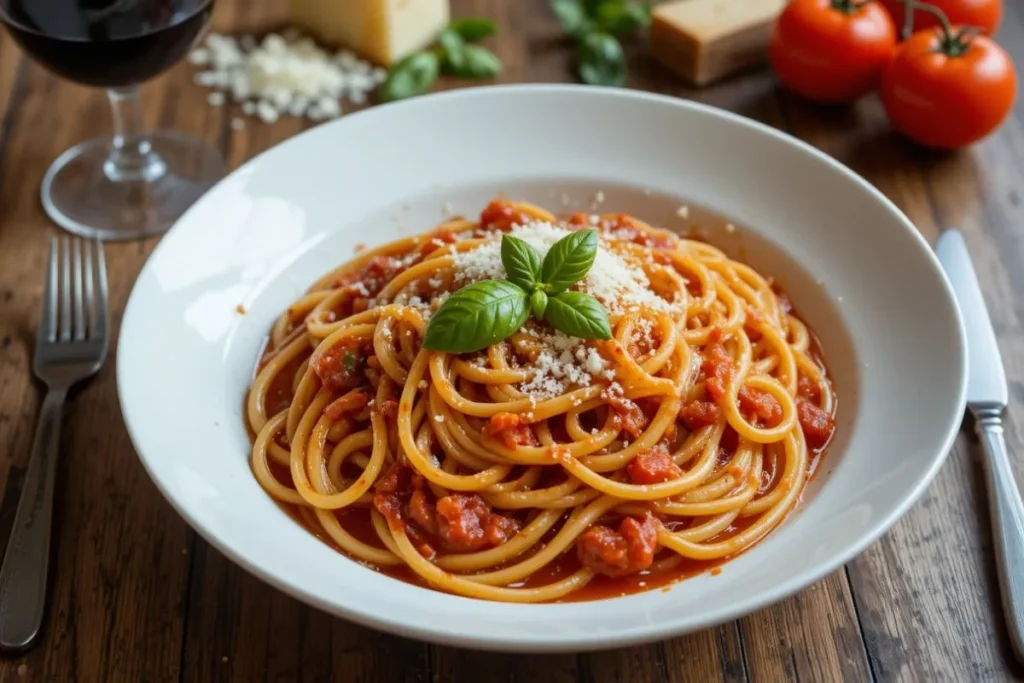
Choosing the Right Type of Pasta
Pasta is not a one-size-fits-all food. With hundreds of shapes and sizes, choosing the right one for pastasciutta is half the battle. Traditionally, long pastas like spaghetti, linguine, or fettuccine are ideal for light sauces, while short pastas such as penne, rigatoni, or fusilli work better with chunkier, meat-based sauces.
Each shape offers a unique experience. For instance:
- Spaghetti: Perfect for smooth tomato sauces or aglio e olio.
- Rigatoni: Great for holding thick sauces thanks to its ridges and large center.
- Farfalle (bow-tie pasta): Often used in lighter, cream-based pastas.
- Orecchiette: Common in southern Italy, ideal for vegetable-based sauces like broccoli rabe and sausage.
Fresh pasta can also be used for pastasciutta, especially in northern regions of Italy. Egg-based pasta like tagliatelle or pappardelle adds a luxurious texture, particularly when paired with hearty ragùs or mushroom sauces.
The most important rule? Don’t overcook your pasta. Aim for “al dente,” an Italian phrase meaning “to the tooth,” indicating pasta that’s firm to the bite. It should be firm when bitten but not hard. This ensures the pasta holds up well when mixed with the sauce and doesn’t turn into mush.
Essential Ingredients for the Sauce
The soul of pastasciutta lies in its sauce. And while there’s a world of variety, most sauces start with a few core ingredients:
- Tomatoes: Whether fresh, canned, or in paste form, tomatoes are foundational. San Marzano tomatoes, celebrated for their sweetness and low acidity, are particularly valued.
- Garlic and Onion: These aromatics provide a flavor base for almost any sauce.
- Olive Oil: Extra virgin is preferred for its deep flavor and numerous health benefits.
- Herbs: Basil and oregano are classics, but thyme, parsley, or bay leaves can also be used depending on the recipe.
- Salt and Pepper: Basic seasonings that bring out the depth of all the ingredients.
- Meat (optional): Ground beef, sausage are often included for a hearty ragù.
- Cheese: Grated Parmigiano-Reggiano or Pecorino Romano adds a salty umami kick at the end.
The beauty of pastasciutta sauce is that it can be as simple or as complex as you like. A basic tomato and basil sauce can be whipped up in under 30 minutes, while a slow-cooked meat ragù might take hours—but the flavor payoff is always worth it.
Optional Additions for Flavor Enhancement
Want to take your pastasciutta to the next level? Here are some optional but delicious additions:
- Red pepper flakes: Add a hint of spicy heat.
- Anchovies: Melted into the oil for a deep, savory umami flavor.
- Capers or olives: Great for a salty, briny contrast in tomato sauces.
- Wine: A splash of red or white wine can add complexity to the sauce.
- Cream or butter: Used sparingly, these can create a richer mouthfeel.
You can also get creative with seasonal vegetables like zucchini, eggplant, or mushrooms. Leafy greens like spinach or arugula can be stirred in just before serving for a pop of color and nutrition.
Step-by-Step Pastasciutta Recipe
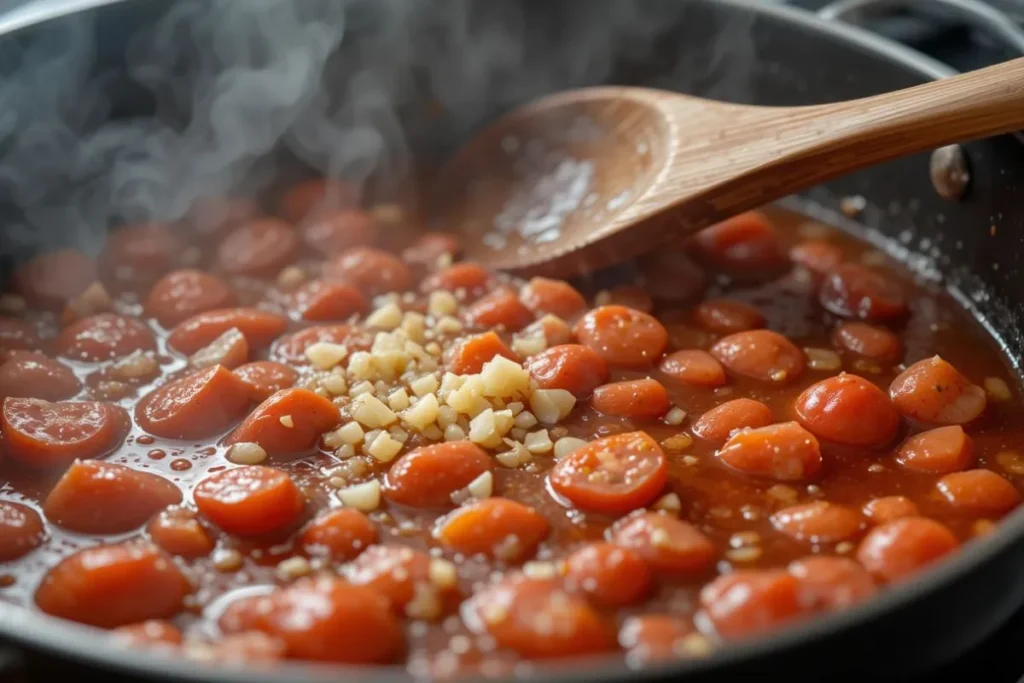
Preparation Before Cooking
Before you even turn on the stove, preparation is key. In Italian kitchens, the concept of “mise en place” — having everything ready — is taken seriously. It’s not just about efficiency; it’s about cooking with intention. When you’re working with a few high-quality ingredients, timing becomes everything. So, let’s break this down.
Start by gathering your ingredients. You’ll need:
- 400g of your favorite pasta (spaghetti, penne, or rigatoni work great)
- 2 tablespoons extra virgin olive oil
- 1 medium onion, finely chopped
- 2 garlic cloves, minced
- 400g canned peeled tomatoes or passata
- Salt and black pepper to taste
- A handful of fresh basil leaves
- Grated Parmigiano-Reggiano or Pecorino Romano
If you’re planning to add meat, sauté about 200g of ground beef or pork before cooking the sauce. Want to make it vegetarian? Dice up mushrooms or eggplant for a meaty texture.
Fill a large pot with water, add a generous pinch of salt (the water should taste like the sea), and set it on high heat to boil. Meanwhile, prepare your sauce base in a separate pan. Trust me, having everything ready before you start cooking will make the whole process seamless.
Get your chopping done. Measure out your oil. Rinse your basil. Grate your cheese. These simple steps will save you from rushing later, and they help preserve the integrity of the ingredients — something every good pastasciutta depends on.
Cooking the Pasta
Cooking pasta sounds simple — boil water, add pasta, wait — but doing it right takes a bit more finesse. Start by making sure your water is at a full, rolling boil. Add your pasta and give it a quick stir to prevent sticking. Don’t break long noodles like spaghetti; Italians never do this because it changes how the pasta interacts with the sauce.
Set a timer according to the instructions on the package, but shave off a minute or two. Pasta should be prepared “al dente,” retaining a slight firmness when tasted. Why is this important? Because it’ll continue cooking slightly once you mix it with the hot sauce.
During the final minute of cooking, reserve about a cup of the starchy pasta water. This is liquid gold — it helps emulsify and bind the sauce to the pasta for that velvety finish you’ve tasted at restaurants but could never quite replicate at home.
Drain the pasta, but don’t rinse it. Rinsing removes the surface starches that help the sauce cling. Now, your pasta is ready to meet its sauce soulmate.
Making the Sauce
Ah, the sauce — the heart and soul of pastasciutta. Whether you’re making a meat ragù or a simple tomato sauce, the process follows the same basic structure.
Heat your olive oil over medium heat. Add the chopped onion and let it soften until it turns translucent — about 5-7 minutes. Then add the garlic and sauté for another 30 seconds, just until it becomes fragrant. Be careful not to burn it; burnt garlic turns bitter and can ruin the sauce.
Now, pour in your tomatoes. If you’re using whole canned tomatoes, crush them gently with a spoon or your hands. Add salt, pepper, and a couple of torn basil leaves. If you’re feeling fancy, a splash of red wine wouldn’t hurt at this stage — just cook off the alcohol for a minute or two.
Allow the sauce to simmer for at least 20 minutes; the longer it cooks, the richer its flavor becomes. Stir occasionally and adjust the seasoning as needed. If your sauce is too acidic, a pinch of sugar can help balance it out.
Once the sauce has thickened and your kitchen smells like heaven, it’s time to bring everything together.
Combining Pasta and Sauce

This step might seem straightforward, but it’s where many go wrong. Don’t just plop the sauce on top of the pasta like a cafeteria lunch. Instead, combine them in the pan to let the flavors truly meld.
Transfer your drained pasta into the sauce pan. Turn the heat to low and gently toss or stir to coat the pasta evenly. If it looks dry, add a splash of that reserved pasta water you saved earlier. This starchy liquid helps the sauce adhere beautifully to the pasta, giving it a silky, restaurant-quality texture.
Let the pasta cook in the sauce for about 1-2 minutes. Then remove from heat and toss in your grated cheese and fresh basil. The heat will melt the cheese slightly, creating a creamy, luscious finish without adding cream.
Serve immediately. Pasta waits for no one.
Pro tip: For an extra touch, drizzle a little high-quality olive oil on top just before serving. It adds aroma and depth that makes each bite unforgettable.
Variations of Pastasciutta
Meat-Based Pastasciutta
This is where the magic of Italian comfort food truly comes alive. Meat-based pastasciutta, often called ragù, is a hearty, flavor-packed version of the classic. The most iconic is Bolognese — slow-cooked ground beef (and sometimes pork) simmered with onions, carrots, celery, tomatoes, and a splash of wine.
To make a proper meat sauce, start by browning the meat until it develops a deep, caramelized color. This step is crucial — don’t just gray the meat; give it time to brown and build flavor. Add your soffritto (the holy trinity of finely chopped onion, carrot, and celery), then your tomatoes, and let it all simmer gently for at least an hour, longer if possible.
For a southern Italian twist, sausage and fennel with spicy tomato sauce is a crowd-pleaser. Or try a Neapolitan ragù with big chunks of pork or beef, cooked slowly in a tomato sauce until melt-in-your-mouth tender.
Whatever meat you use, the key is patience. Let the sauce cook slowly, giving the flavors time to deepen and meld. Pair it with robust pasta like rigatoni or pappardelle, and top it off with a generous shower of Parmigiano-Reggiano.
Vegetarian and Vegan Options
You can relish a hearty and flavorful plate of pastasciutta without including meat. In fact, some of the most beloved Italian recipes are completely plant-based, showcasing vegetables, herbs, and olive oil in a way that’s both wholesome and flavor-packed.
A classic vegetarian choice is Pasta alla Norma, which hails from Sicily. This version uses fried eggplant, a rich tomato sauce, fresh basil, and a sprinkle of ricotta salata or Pecorino cheese. The eggplant provides a hearty, almost meaty texture that makes the dish feel indulgent without any animal products.
For a vegan-friendly option, simply omit the cheese or swap it with nutritional yeast or a plant-based cheese alternative. Mushrooms, particularly porcini or cremini, also make an excellent substitute for meat thanks to their umami-rich flavor. Combine them with garlic, thyme, and a splash of white wine, and you’ll have a sauce that rivals any traditional ragù.
Zucchini, bell peppers, and spinach are other veggies that work well in pastasciutta. They can be lightly sautéed and folded into a tomato base, or simply tossed with garlic and olive oil for a lighter approach.
Looking for something creamy without the dairy? Blend cooked cauliflower or cashews with garlic, onion, and olive oil to create a smooth, velvety sauce that coats pasta beautifully. With the right seasonings, no one will miss the cream or cheese.
Vegetarian and vegan pastasciutta isn’t just a compromise — it’s a celebration of what fresh produce and quality ingredients can do. It’s an open canvas for creativity and flavor.
Regional Variants Across Italy
One of the most fascinating things about pastasciutta is how its form changes as you travel through Italy. Each region has its own unique spin, often shaped by geography, history, and local produce.
- Tuscany: Expect rustic meat sauces and hand-rolled pasta like pici, often paired with wild boar ragù or rich tomato-based sauces.
- Emilia-Romagna: The home of tagliatelle al ragù (aka Bolognese), and a region known for its deeply flavorful, slow-cooked sauces with ground meats and finely chopped vegetables.
- Campania: Known for tomato-rich sauces and the classic Spaghetti alla Puttanesca, which features olives, capers, garlic, and anchovies for a briny, bold flavor.
- Sicily: Offers dishes like Pasta alla Norma and pastas with sardines, raisins, and pine nuts—an Arab-influenced flavor combo that’s both sweet and savory.
- Liguria is known for trofie al pesto—short, spiraled pasta paired with basil pesto, potatoes, and green beans.
Even within the same region, towns and families will have their own guarded recipes passed down through generations. That’s what makes pastasciutta so magical — it’s both personal and universal, with no single “right” way to make it.
Tips and Tricks for the Best Pastasciutta
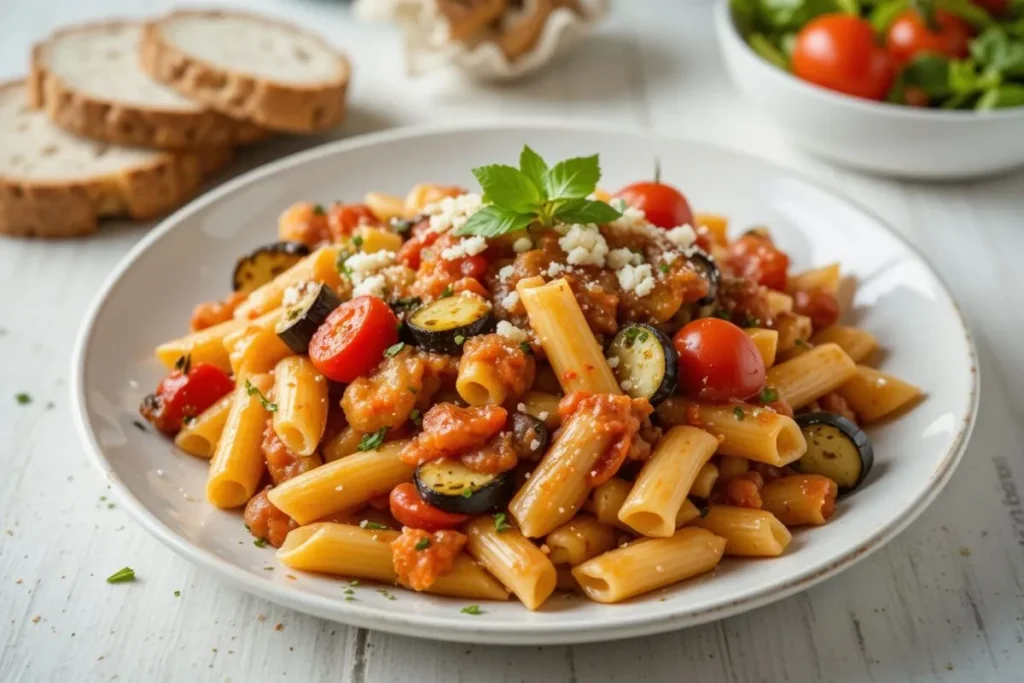
How to Avoid Overcooked Pasta
Nothing ruins a perfect pastasciutta faster than overcooked pasta. The texture turns mushy, the sauce slides off, and that beautiful al dente bite is gone. To avoid this, follow a few simple rules:
- Use plenty of water: A large pot prevents pasta from sticking together.
- Generously salt the cooking water, as it’s your only opportunity to directly flavor the pasta.
- Stir during the initial minutes of cooking to prevent the pasta from clumping.
- Start testing early: Check the pasta a minute or two before the time indicated on the package. It should resist slightly when bitten.
- Don’t rinse: Rinsing removes starches that help the sauce cling to the pasta.
- Toss pasta with sauce immediately: This final “marriage” of pasta and sauce ensures every bite is flavorful.
Remember, pasta will continue cooking a bit after you drain it, especially if you’re mixing it into a hot pan of sauce. So always aim for slightly underdone if you plan to finish cooking it together with your sauce.
Balancing Flavors in the Sauce
Great pastasciutta is all about harmony. The sauce shouldn’t be too acidic, too oily, or overly spiced. Every ingredient should play a role without overshadowing the others.
- Tomato too sharp?Add a small amount of sugar or a touch of cream to soften its intensity.
- Too bland? Boost it with more garlic, herbs, or a little grated cheese.
- Lacking body? A bit of reserved pasta water or a knob of butter can add richness.
- Overly salty? A few diced, cooked potatoes can absorb excess salt and balance the flavor.
Taste your sauce often, and don’t be afraid to tweak as you go. Italian cuisine isn’t defined by strict guidelines; it’s guided by instinct and harmony.
Also, fresh herbs should be added at the end to preserve their brightness, while dried herbs are best added earlier to release their full aroma.
Storing and Reheating Leftovers
Let’s be honest—pastasciutta tastes even better the next day. The flavors have had time to meld, and it makes a fantastic quick meal or lunchbox option. But storing and reheating it the right way ensures you don’t end up with a dry or rubbery mess.
- Storage: Let the pasta cool slightly before transferring it to an airtight container. Keep it in the refrigerator for up to three to four days.
- Freezing: Yes, you can freeze pastasciutta! Use freezer-safe containers or bags. Label them with the date and eat within 2 months for best quality.
- Reheating: Reheat in a pan with a splash of water or broth to revive the sauce. Avoid microwaving unless necessary, and if you do, cover it and stir halfway through to ensure even heating.
Bonus tip: If you’re making pastasciutta in bulk, undercook the pasta slightly before storing. This prevents it from becoming overly soft during reheating.
Conclusion
Pastasciutta is more than just an Italian dinner staple—it’s a symbol of simplicity, tradition, and culinary joy. From the bustling kitchens of Rome to the quiet tables of small Tuscan villages, this dish unites generations over steaming plates of perfectly sauced pasta.
Whether you prefer it rich with meat, light with olive oil and vegetables, or bold with regional spices and herbs, pastasciutta adapts to your mood and pantry alike. It’s comfort food with elegance, weekday dinner with soul, and a dish that proves once and for all: the simplest things in life are often the most satisfying.
So next time you’re wondering what to cook, just remember—boil some pasta, make a good sauce, and enjoy the magic that is pastasciutta.
FAQs
Can I use gluten-free pasta for pastasciutta?
Absolutely! Gluten-free pasta has come a long way and works well in most pastasciutta recipes. Just be careful not to overcook it, as it can get mushy faster than regular pasta.
What’s the difference between pastasciutta and pasta al forno?
Pastasciutta is typically cooked pasta mixed with sauce and served immediately. Pasta al forno, on the other hand, is baked pasta, often with layers of sauce, cheese, and sometimes meat, then baked until bubbly and golden.
Can I freeze pastasciutta?
Yes! Let it cool first, then store in a freezer-safe container. It’s best eaten within two months. Reheat gently on the stovetop with a splash of water or broth to revive the sauce.
How long does pastasciutta last in the fridge?
It will stay fresh for 3-4 days in the refrigerator. Ensure it’s kept in an airtight container.
Can I make pastasciutta without tomato sauce?
Of course! Olive oil, garlic, herbs, and even creamy sauces can all be used. Try aglio e olio or a pesto-based pastasciutta for a change of pace.

